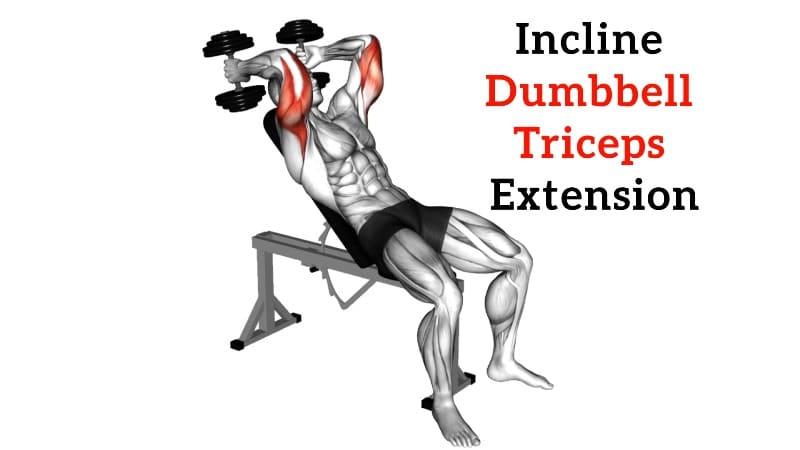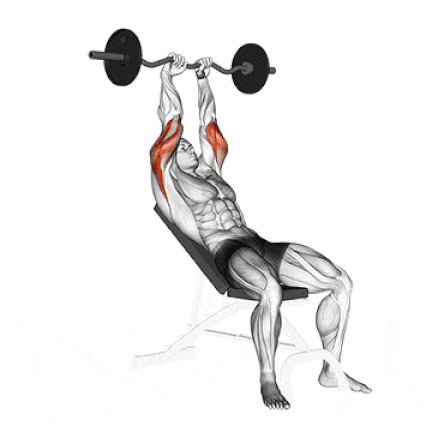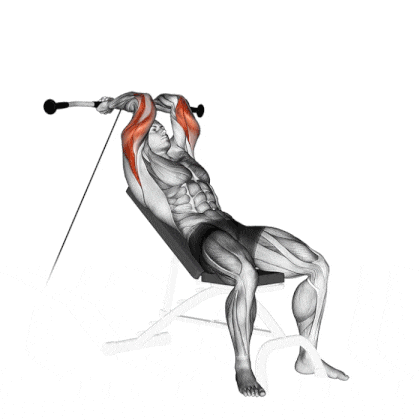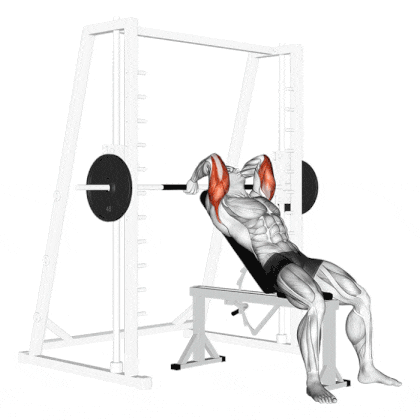The Incline dumbbell tricep extension is very effective for targeting the triceps brachii. It resembles the incline skull crusher but has a slightly different movement pattern.
Unlike skull crushers, where the weight is brought down towards your skull, the incline dumbbell tricep extension focuses on extending your arms behind your head while lying on an incline bench (typically set at 30–45 degrees).
Research shows that overhead or incline triceps extensions lead to significantly greater triceps hypertrophy, especially in the long head, compared to neutral-arm positions, even when using lighter weights.
Want to take your gains to the next level? Discover your daily calorie needs with our free TDEE calculator

Incline Dumbbell Tricep Extension Muscles Worked
The tricep extension is an isolation exercise rather than a compound motion, which makes it great for targeting the triceps.
- Primary Muscles (Major Contributors): Triceps (long head, medial head, lateral head)
- Secondary Muscles (Assisting Muscles): Forearms (brachioradialis, wrist extensors) and Anterior Deltoid.
- Stabilizers (Prevent Excess Movement): Rotator Cuff Muscles, Serratus Anterior, Core (Abs & Erector Spinae)
core (abs and lower back).

How To Do Incline Dumbbell Tricep Extension
- Set an adjustable bench to approximately 30-45 degrees incline (I typically recommend 30° for beginners and up to 45° for advanced lifters)
- Sit on the bench with dumbbells resting on your thighs. Lie back, bringing the dumbbells up to your chest.
- Press the dumbbells straight up above your shoulders, palms facing each other (neutral grip) or slightly angled inwards. Your arms should be perpendicular to the floor, or angled slightly back towards your head, to maintain tension on the triceps from the start.
- Keep your upper arms (humerus) relatively stable and perpendicular to the floor (or angled slightly back), and slowly bend only at your elbows.
- Lower the dumbbells in a controlled arc slightly behind your head. Your elbows should point generally towards the ceiling.
- Continue lowering until you feel a deep stretch in your triceps. Your forearms should go just past parallel to the floor, or as far as your comfortable range of motion allows.
- Powerfully extend your elbows to press the dumbbells back up to the starting position. Focus on squeezing your triceps hard.
Tips and Techniques
- Watch your elbows. It can be tempting to allow them to flare out, but try to keep them tucked. You’ll protect your shoulders and really zero in on those triceps.
- Remember your wrist position—don’t let them hyperextend too much. This can cause strain and discomfort. If you’re having trouble, consider using wrist supports or reducing the weight.
- Keep your arms straight and parallel to the ground. Any forward or backward movement can distract from your triceps and lessen the exercise’s effectiveness.
- Avoid jumping straight into heavy sets. Always start with a proper warm-up to prepare your triceps and elbows.
- It’s easy to get carried away and try to lift too heavy, but that can lead to compromised form and potential injury. Always prioritise proper technique over maxing out the weight.
- Ensure you’re lowering the weight down and fully extending your arms at the top. Cutting the movement short reduces the exercise’s effectiveness.
- Although extensions are safe, moderate loads are recommended to avoid excessive stress on the elbow joints in the long term.
- Vary bench angles to hit different angles of the tricep, but do not go beyond 60 degrees.
- Perform 3–4 sets of 8–12 reps, with 60-90 seconds rest, using a weight that brings you near failure while maintaining proper form.
3 Best Variations of Incline Tricep Extension
Here are 3 ways to do this exercise to build bigger and stronger triceps.
1. Ez Bar Incline Tricep Extension
The angled grips of an EZ curl bar allow for a more semi-pronated or semi-supinated hand position (somewhere between fully palms down and palms facing each other).
This position is more anatomically natural and comfortable for the wrists and elbows than a straight bar. In some cases, it is even more so than dumbbells if wrist stability is a concern.
Holding one thing with both hands can be more stable than lifting two dumbbells. Sometimes, this extra stability makes it safe to use slightly heavier loads.

2. Incline Cable Tricep Extension
One of the best things about cables is that they keep the tension the same throughout the movement.
Unlike free weights, which can have a varying load depending on the position, cables keep your triceps engaged from start to finish. This can amp up the intensity and help you see better results.
You can use different attachments and grips with cables, like a rope or a straight bar. So you must try the Incline cable triceps extension.

3. Smith Machine Incline Tricep Extension
The Smith machine’s fixed path helps keep the barbell steady, so you can focus more on your form without worrying about balancing the weight.
The fixed bar path ensures that your triceps perform most of the work, thereby minimising the involvement of other muscle groups.
But like anything in the gym, it’s just one tool in the box. Mix it up, use it wisely, and listen to your body.


Manish is a NASM-certified fitness and nutrition coach with over 10 years of experience in weight lifting and fat loss fitness coaching. He specializes in gym-based training and has a lot of knowledge about exercise, lifting technique, biomechanics, and more.
Through “Fit Life Regime,” he generously shares the insights he’s gained over a decade in the field. His goal is to equip others with the knowledge to start their own fitness journey.
